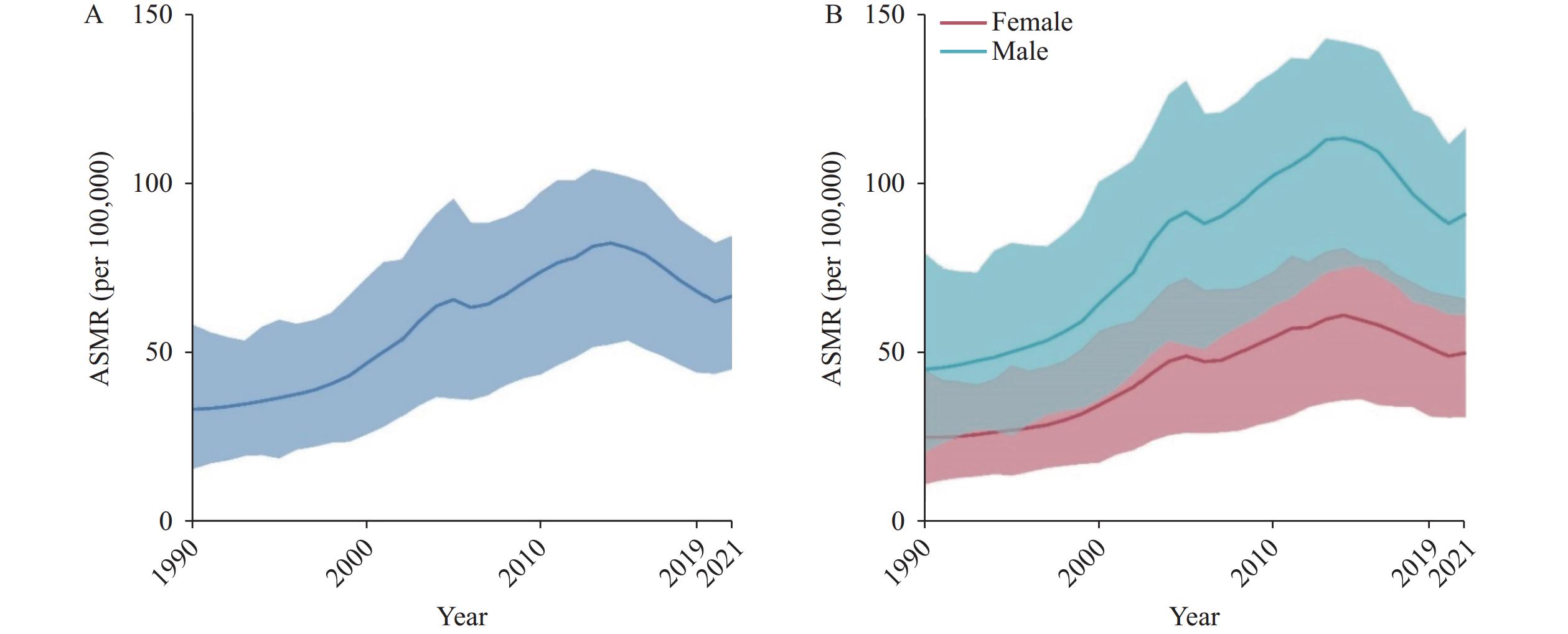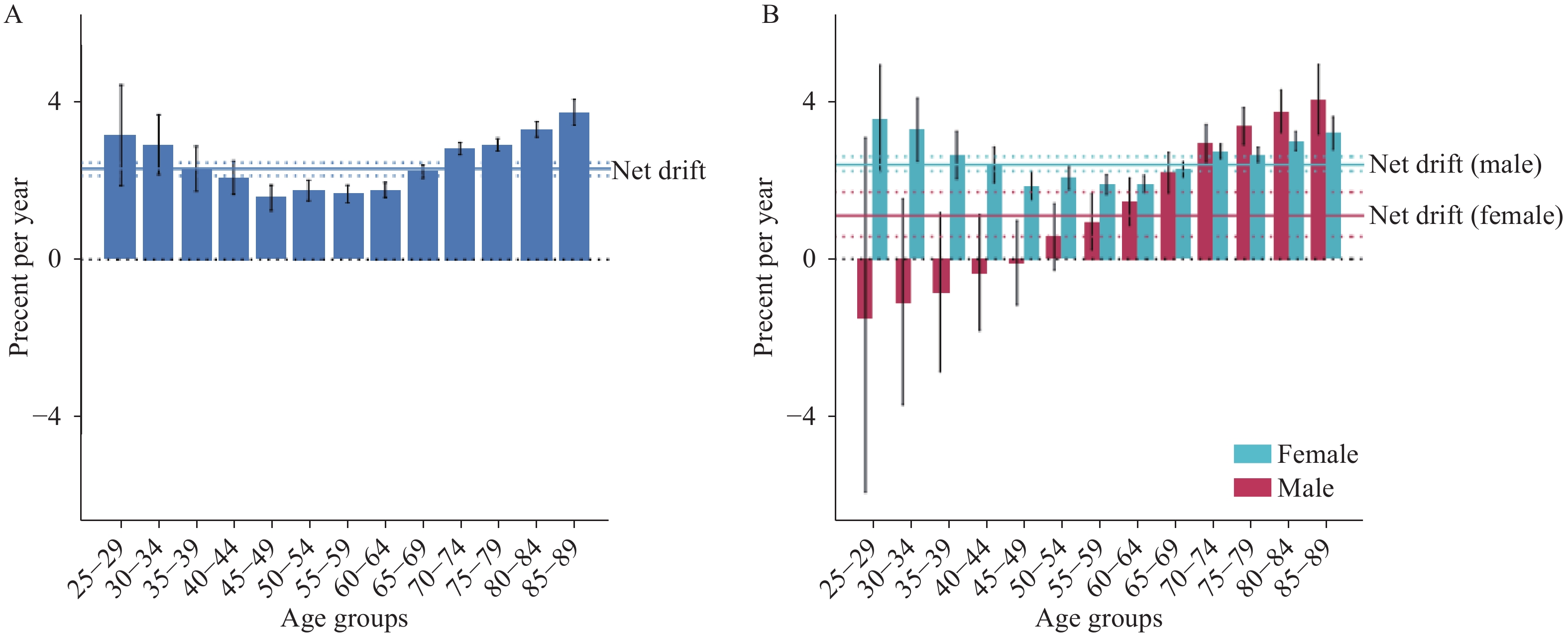-
Cardiovascular disease (CVD) is a leading cause of death and disability in China. This study aims to assess the long-term trends of ambient particulate matter pollution (APMP) attributable CVD mortality in China. Data were extracted from Global Burden of Disease 2021 and an age-period-cohort was used. From 1990 to 2021, APMP-attributable CVD mortality increased by 101.6% in China (increased by 101.8% in males and 100.0% in females). The mortality risk associated with APMP-attributable CVD decreased recently for both males and females (after 2017). In different birth cohort, the mortality risk continued to increase in males but decreased in females born after 1971. More effective efforts are needed to mitigate the increasing trends of APMP-attributable CVD mortality, especially for males.
CVD represents a substantial public health burden in China, contributing significantly to mortality and disability while imposing considerable strain on the healthcare system through rapidly escalating costs (1). By 2020, CVD accounted for approximately two-fifths of all deaths in China (2). APMP has emerged as a critical risk factor for CVD development. Chronic exposure to APMP has been associated with increased risk of various cardiovascular conditions, including atherosclerosis, hypertension, coronary heart disease, and stroke (3).
Understanding the CVD burden attributable to APMP exposure in the Chinese population is crucial for developing evidence-based prevention strategies. This study characterizes the longitudinal trends of APMP’s impact on CVD mortality and examines the underlying factors driving these patterns. Our findings provide valuable insights into the health burden of APMP-attributable CVD in China, which may inform future public health interventions and policy decisions.
Data on APMP-attributable CVD mortality were obtained from the Global Burden of Disease (GBD) 2021 database (4–5). APMP measurements integrated multiple data sources, including ground monitoring stations, satellite aerosol observations, chemical transport modeling, population estimates, and land-use data. APMP was defined as the population-weighted annual average daily exposure to outdoor particulate matter with an aerodynamic diameter less than 2.5 μg per cubic meter of air (4). APMP-attributable CVD mortality was calculated using exposure levels compared against a theoretical minimum risk exposure level counterfactual scenario. The exposure-response relationships were derived from cohort studies, pooled cohort analyses, and randomized controlled trials. Population data were sourced from the 2022 Revision of World Population Prospects (WPP), which incorporated national censuses, vital registration systems, and representative population surveys.
An age-period-cohort (APC) analysis was conducted to elucidate the underlying effects driving long-term trends in APMP-attributable CVD mortality. The analysis utilized mortality and population data categorized into consecutive 5-year periods (1992–2021) and 5-year age intervals (25–89 years). Data from 1990–1991 were excluded due to insufficient data for complete 5-year periods. The following parameters were estimated: net drift (overall annual percentage change), local drift (age-specific annual percentage changes), longitudinal age curve (age-specific mortality risk), period relative risk (RR) (temporal variations in mortality risk), and cohort RR (birth cohort-specific mortality risk). Parameter estimation was performed using the National Cancer Institute’s R program (6). Statistical significance of estimable parameters and functions was assessed using Wald chi-square tests. Analyses were conducted using R (version 4.2.1; R Foundation for Statistical Computing, Vienna, Austria) 4.2.1, with statistical significance set at P<0.05.
Figure 1 illustrates the temporal trends in age-standardized APMP-attributable CVD mortality. In 2021, the age-standardized mortality rate per 100,000 population was 66.4 [95% uncertainty interval (UI): 44.9, 84.2] for both sexes combined, with rates of 90.7 (95% UI: 61.1, 116.0) for males and 49.9 (95% UI: 30.9, 65.9) for females. Between 1990 and 2021, the age-standardized mortality rate increased by 101.6% overall, with similar increases observed in both males (101.8%) and females (100.0%). The mortality rate peaked in 2014 at 82.1 (95% UI: 52.2, 102.9) per 100,000 population, followed by a declining trend that was interrupted in 2021.
 Figure 1.
Figure 1.Temporal trends in age-standardized APMP-attributable CVD mortality in China, 1990–2021. (A) Combined trends for both sexes; (B) Sex-specific trends for males and females.
Note: Shaded areas represent 95% uncertainty intervals.
Abbreviation: ASMR=age-standardized mortality rate; APMP=ambient particulate matter pollution; CVD=cardiovascular disease.
The net drift, representing the annual percentage change in expected age-adjusted rates over time, was 2.3% [95% confidence interval (CI): 2.1%, 2.5%] for APMP-attributable CVD mortality, with males showing 2.4% (95% CI: 2.2%, 2.6%) and females showing 1.1% (95% CI: 0.6%, 1.7%) (Figure 2).
 Figure 2.
Figure 2.Net drift and local drift values for APMP-attributable CVD mortality in China. (A) Combined net and local drift values for both sexes; (B) Sex-stratified net and local drift values.
Note: Net drift represents the annual percentage change in expected age-adjusted rates over time; local drift indicates the annual percentage change in expected age-specific rates over time. The color bar displays local drift values by age group. Vertical bars indicate 95% CI. The horizontal colored line shows the net drift (solid line) with its 95% CI (dashed line). Abbreviation: APMP=ambient particulate matter pollution; CVD=cardiovascular disease; CI=confidence interval.Local drift analysis, which measures the annual percentage change in expected age-specific rates over time, revealed significant positive values (P<0.05) for both males and females aged over 55 years. Peak local drift values were observed at 3.6% (95% CI: 2.2%, 4.9%) in males aged 25–29 years and 4.1% (95% CI: 3.2%, 4.9%) in females aged 85–89 years.
The longitudinal age curve, representing the age effect, demonstrates that APMP-attributable CVD mortality increased dramatically with age, rising from 0.7 per 100,000 population in the 25–29-year age group to 3,470.0 in the 85–89 age group. This pattern of exponential increase with age was consistent across both males and females (Figure 3A).
 Figure 3.
Figure 3.Age, period, and cohort effects on APMP-attributable CVD mortality in China. (A) Longitudinal age curves; (B) Period RR trends; (C) Cohort RR trends.
Note: Longitudinal age curves indicate age-specific effects. Vertical bars represent 95% confidence intervals (some intervals too narrow for visual display).
Abbreviation: APMP=ambient particulate matter pollution; CVD=cardiovascular disease; RR=relative risk.
The period and cohort effects, expressed as relative risk (RR), represent the ratio of age-specific rates in each period or cohort relative to their respective reference groups. Period RRs showed an upward trend for both males and females until 2017, followed by a decline in mortality risk during the most recent period (2017–2021) (Figure 3B). The cohort effect analysis revealed divergent patterns between genders: males demonstrated a continuous increase in RR across successive birth cohorts, while females showed a decreasing trend in mortality risk for cohorts born after 1971 (Figure 3C).
-
This study elucidated the long-term trends and underlying determinants of APMP-attributable CVD mortality in China. Between 1990 and 2021, age-standardized APMP-attributable CVD mortality increased substantially in both males and females. Although recent period effects showed favorable decreases in mortality risk, cohort analysis revealed a concerning pattern where mortality risk continued to rise in males across successive birth cohorts.
The age effect analysis demonstrated that APMP-attributable CVD mortality increased exponentially across age groups. This pattern reflects the heightened vulnerability of individuals with prolonged exposure to air pollution particles, compounded by age-related physiological changes that increase susceptibility to environmental influences (7). Given China’s ongoing demographic transition and aging population, the CVD burden is projected to escalate (8). These findings underscore the critical need for targeted public health interventions to promote cardiovascular health among elderly populations, particularly those with extended exposure to ambient particulate matter pollution.
Period effects arise from external factors that uniformly influence all age groups during specific time intervals. Our analysis revealed a decrease in APMP-attributable CVD mortality risk in recent years, likely attributable to the implementation of comprehensive emission reduction policies and health promotion programs. The Air Pollution Prevention and Control Action Plan, implemented in China in 2013, achieved a 33.3% reduction in average annual APMP concentration by 2017. This initiative resulted in the prevention of 47,240 deaths through significant improvements in air quality (9).
Our findings demonstrated that the risk of APMP-attributable CVD mortality showed a consistent decline among females in birth cohorts after 1971. This reduction may be attributed to advances in CVD management, particularly improvements in early diagnosis and treatment protocols, combined with the substantial expansion of healthcare resources that has enabled broader access to essential medical services (10). However, these favorable trends were not observed in males, where mortality risk increased across successive birth cohorts. More targeted interventions are needed to address and reverse this concerning trend among male birth cohorts.
While this study provides valuable population-level insights into APMP-attributable CVD mortality trends, several limitations warrant consideration. First, as an ecological study, our population-level findings may not directly translate to individual-level associations. Second, APMP-attributable CVD mortality likely varies between rural and urban areas in China; however, we could not assess these geographic trends separately as the Global Burden of Disease Study does not disaggregate data by urbanization status. Despite these limitations, our findings provide crucial insights for future initiatives aimed at reducing APMP-attributable CVD mortality.
-
Global Burden of Disease Study 2021 team and the National Center for Chronic and Noncommunicable Disease Control and Prevention, Chinese Center for Disease Control and Prevention for their contributions.
HTML
| Citation: |



 Download:
Download:




